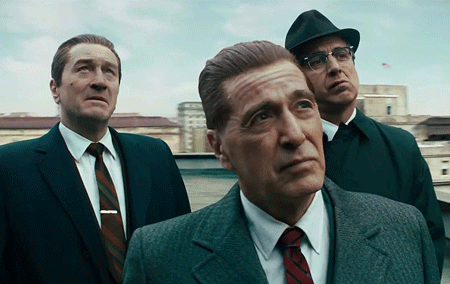Netflix launches a major offensive in the Streaming Wars
Netflix fights back at the entry of new players in streaming by offering Oscar-nominated content almost the same day as movie theaters. Does it offer enough value to keep subscribers from switching services?
By Jeffrey Cole
It’s an easy question. When Netflix offers theatrical films at what feels like the same time they appear in the theater as part of their $12 monthly charge (with massive amounts of additional content) can movie theaters survive asking $10-$16 a person for one ticket?
The obvious answer is no.
Now that Apple, Disney, HBO, and NBC are offering their own streaming services, Netflix is facing unprecedented competition that may represent an existential threat. It no longer has the field largely to itself (along with Hulu), and will have to innovate and adapt. In a recent column, I outlined five things it will have to change (less but better programming, accept advertising and more).
 Netflix’s December premieres of The Irishman, Marriage Story and The Two Popes was a brilliant counteroffensive to the high-profile programming and lower subscription costs of Disney and Apple.
Netflix’s December premieres of The Irishman, Marriage Story and The Two Popes was a brilliant counteroffensive to the high-profile programming and lower subscription costs of Disney and Apple.
Although not literally day and date (releasing a film into the home the same day as the movie theater), to the viewer it felt as if it were. For five years, we have been predicting that some studio would experiment and release a film into the home the same day it appeared in the theater. We just expected it would cost about $50, rather than as part of a $12 subscription.
It raises a question: why did Netflix even bother to release those three films into a theater? At a media conference with about 1000 people in the audience in November, a few days after The Irishman opened in theaters, I asked how many planned to see it that way: about six hands went up. With 55-inch or bigger screens in the living room, it made sense to watch it at home.
Netflix opened The Irishman in a small number of theaters and then ran it 26 days later on its streaming service. Before this, the window had been as short as 72 days. November is a weak month for theater attendance anyway. Immediately after Thanksgiving, when people had time and interest, Martin Scorsese’s film was already on Netflix. Obviously, it only opened in theaters at all (with little revenue) to meet the theatrical release requirement for Academy Awards and to increase the buzz for streaming by gathering Oscar nominations.
The plan worked. The Irishman was the second most-nominated film with ten nods, including best picture.
For the three films Netflix released with extremely short windows, they sought out those most likely to appeal to Oscar voters. Marriage Story was nominated for six, including best picture, actor, and actress, while The Two Popes gathered three nominations: actor, supporting actor, and adapted screenplay.
Picking up such high-profile movies is extremely expensive. Netflix, with its soon-to-be $17 billion for original production, has the money. They spent $159 million (plus marketing) for The Irishman, a film every other studio passed on. While anyone could see the Oscar potential for the organized crime story, no studio saw the ability to make money on the film.
Netflix operates on a different standard and metric than movie studios or television networks. There are no box office numbers or advertising revenue to report as victories at the end of the week.
The only metric that matters to Netflix is keeping their monthly subscribers happy so they don’t cancel their subscription or move elsewhere. By that metric, Netflix must be very happy.
Disney+ attracted great attention and reviews with the premiere of the eight-episode, Star Wars themed show, The Mandalorian, as well as their innovative, six-part documentary, The Imagineering Story.
___________________________________________________________________________
Now that Apple, Disney, HBO, and NBC are offering their own streaming services, Netflix is facing unprecedented competition that may represent an existential threat. It no longer has the field largely to itself (there always has been Hulu), and will have to innovate and adapt.
___________________________________________________________________________
It shows how far home entertainment has come that viewers now expect massively expensive, beautiful looking, compelling mini-series (The Crown, The Handmaid’s Tale, and many others) as part of their $10-$12 monthly subscriptions. Netflix has excelled at delivering this kind of value since they premiered their first original, House of Cards.
The three December movies took this to a new level. Subscribers could say, “Now Netflix is giving me three Oscar-nominated films as part of my monthly package that I would be likely to see in the theater. Wow.”
The value is extraordinary. Using average ticket prices and forgetting about food (a major part of the theater expense), if a household of three (these three films are not child friendly—but others to follow will be)—were to see one of these films in a theater, the cost would be $36. That’s $24 more than the monthly subscription. If they were to see all three, it would be $108, which is $96 more than a month of Netflix. Of course, that subscription adds hundreds of additional hours or originals and other content. Few people go to the theater without spending $10-$15 per person on food as well as parking and other costs.
While successful with subscribers, Netflix’s bold, unprecedented move has angered powerful constituencies in the entertainment world. The studios and creative community fear the declining importance of movie theaters, where they want their art to be seen on big screens with all their majesty. There was pushback last year when Netflix also released (with a very short window) a much smaller film, Roma. While this year’s three Netflix films were nominated for 19 Academy Awards, look for the studios and creative community to show their displeasure shutting the three films out of the major Oscars.
And the theater owners continue to be angry at the changing world of watching content. From their perspective, these three films (at least two with the potential for big box office) were irrelevant. They fear the direction movie watching is going and their inability to do anything to stem the tide.
Knowing it would face serious threats from programming such as The Mandalorian or Apple’s The Morning Show, Netflix found a brilliant way both to compete and also to show their viewers that they were getting an extraordinary value. Netflix successfully moved the conversation from, “should I subscribe,” to “I can’t give up Netflix, look at how much money I’m saving.”
Even if they didn’t particularly like Netflix’s first three movies to go this route, they have to respect the Oscar nominations and know that more content to their liking may be on its way.
____________

Jeffrey Cole is the founder and director of The Center for the Digital Future at USC Annenberg.
See all columns from the center.
February 5, 2020

